Description of diseases and pests of strawberries and their control

Strawberries, like any other crop, are prone to a variety of diseases. The treatment of each of them involves certain manipulations and the use of special means. In this article, we will take a closer look at the description of the most common diseases and pests of strawberries, as well as find out how to deal with them.
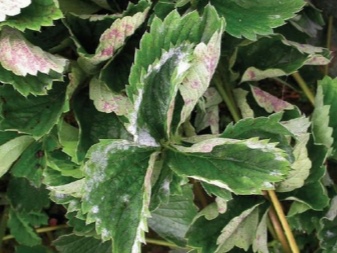
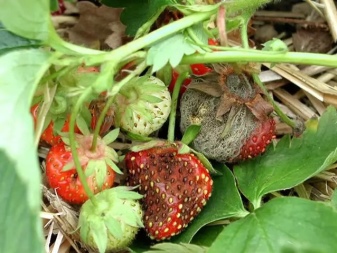
Diseases and their treatment
Strawberries are one of the most popular crops. Many gardeners grow it on their plots. Unfortunately, sweet and bright berries are often subject to many dangerous diseases that can seriously undermine their condition. We are talking about gray rot, brown spot, and many other diseases.
If your culture has suffered from similar problems, there is no need to despair. Strawberry diseases can and should be fought, the main thing is to take action in a timely manner.
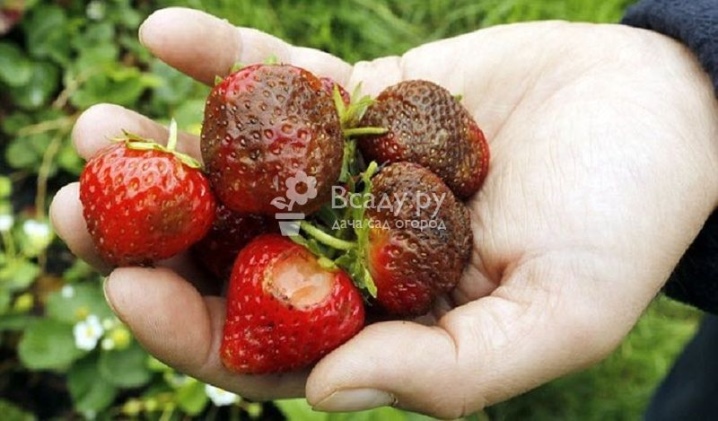
We will learn more about the most common diseases of strawberries, as well as how to get rid of them.
Powdery mildew
Powdery mildew is one of the most common diseases affecting garden berries. This serious ailment manifests itself in the form of a whitish plaque that forms both on the fruits and on the plates of the foliage of the culture. At the same time, the latter are twisted. After a while, this plaque changes its color and becomes dark brown, strong. The berries themselves are covered with many cracks. The foliage dries under the influence of powdery mildew.
At the first signs of the disease in question, it is necessary to take action as soon as possible to eliminate it. Most often, when such a problem occurs, summer residents resort to using folk remedies or preparations containing copper. These include Topaz and Karatan.
In order to prevent this dangerous disease, it is allowed to apply to the procedure for dusting with special colloidal sulfur. A solution of copper sulfate is also suitable.
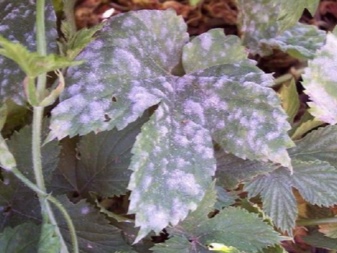

Gray rot
Diseases such as gray and black rot are of great danger. These ailments often affect garden strawberries. The causative agent of gray rot is the fungus Botrytis fuckeliana, which is characterized by a fairly rapid maturation of spores. If the disease attacked the planting, then the fruits are covered with a characteristic layer of gray fluffy bloom. If you touch it, then dust of the same color will immediately rise. It should be borne in mind that this disease is spreading rapidly through the contact method.
Early ripening varieties of garden berries, for example, "Victoria", are not so susceptible to gray rot. This disease can manifest itself only in conditions of favorable factors for it. We are talking about a lack of natural light, high humidity, excess nitrogen in the soil. If these problems occur, then early ripe strawberries can also get sick with gray rot.
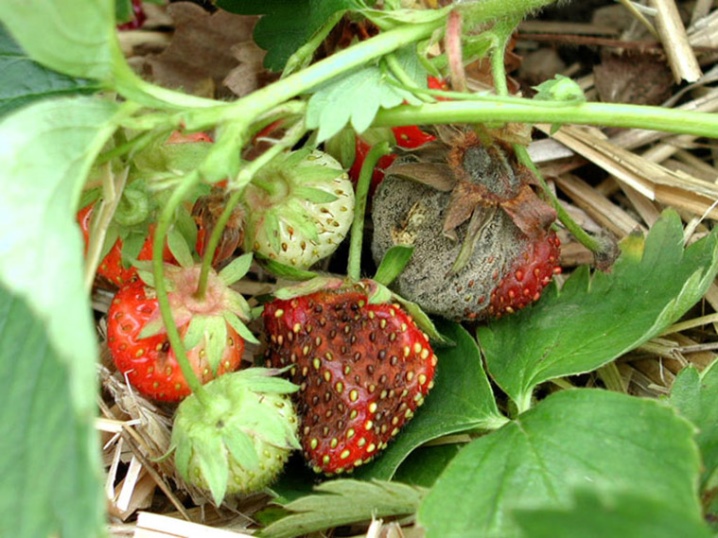
The disease in question must be treated on time. For these purposes, the use of such means as "HOM", "Tirama", "Figona" is ideal. In addition, the summer resident must regularly remove all leaves and fruits that have already been affected by the disease. The bushes need to be thinned, and the amount of watering should be reduced. It is recommended to water the plants with a solution of potassium permanganate, and it is also necessary to mulch with wood ash.
In addition, foliar feeding is recommended.A combination of 2 g of boric acid and 20 drops of iodine mixed in 10 liters of water is ideal for this.
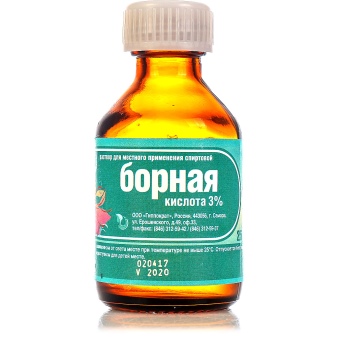

Black root rot (scab)
No less dangerous disease. Its other name is rhizoctoniasis. Initially, the disease manifests itself on the roots of the strawberry, and after a while it moves to that part of the plant that is located above the ground.
Usually, black rot spoils the plants in those beds that are used after growing nightshades on them. The main symptom of the disease in question is the appearance of black and slippery rhizomes. And also the leaf blades turn black, becoming more brittle and fragile. The stems also suffer. Because of these symptoms, an adult bush can be very easily pulled out of the soil in the garden.
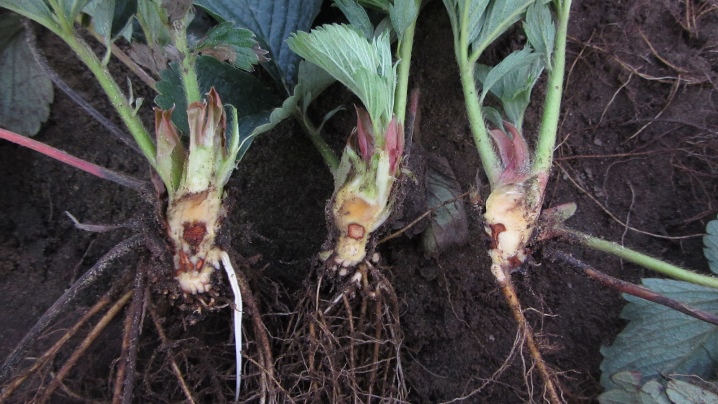
It is almost impossible to completely cope with this dangerous disease. You can only turn to preventive measures in the form of compliance with all the basic rules of agricultural technology when planting plants. Before planting the roots, it is necessary to hold for 3 minutes in hot water or in a solution with Fitosporin, but already for 10 minutes. If the symptomatology touched half of the plant above the ground, then this will indicate that the disease is rapidly progressing.
If the black rot in question appears on several bushes at once, they must be pulled out and destroyed as soon as possible. In this field, the soil will definitely need to be treated with a 3% solution of copper sulfate. And also a very effective Bordeaux liquid is suitable for processing.
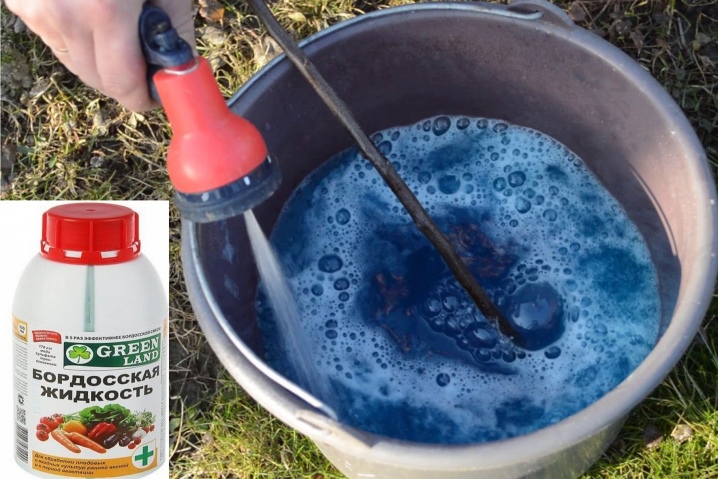
Leathery rot
Another name for this disease is late blight. It poses a great danger not only for strawberries, but also for other crops on the site. The disease can also affect potatoes, tomatoes and other plants.
If strawberry bushes get sick with leathery rot, then they are noticeably deformed. The buds may turn black. Visible brown spots appear on foliage and stems. Affected fruits do not have the most pleasant bitter taste. The root system of a diseased strawberry dries up and becomes very coarse.
If isolated cases of the appearance of leathery rot that attacked the berries were found, then you can resort to digging up diseased bushes. After that, they must be burned, and not just collected in one garbage heap. After that, the land will need to be treated with potassium permanganate.
If the infection with the disease is massive, then the only way out of the situation is the complete cleaning of all the planted plants. After that, the area should be sown with marigolds so that the soil gradually comes to recovery.
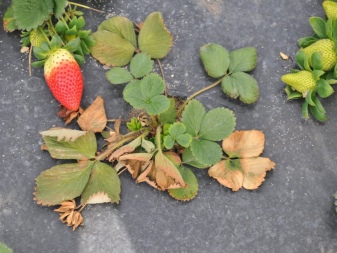

Brown spot
This disease actively affects strawberries and strawberries of various varieties. Its appearance is provoked by the mushroom Marssonina potentilla. There is not only brown, but also white spot. The first disease is more dangerous and aggressive. Brown spotting can lead to a very strong deformation of leaf plates, a sharp slowdown in their growth and even mass death. Because of this, fruiting falls, the quality of the fruit is noticeably deteriorated.
Usually, the development of brown spotting starts in early spring. The active development of the pathogen is facilitated by a temperature regime within 20-25 degrees Celsius, as well as an increased humidity level. Massive damage occurs in the period from August to September, when the amount of precipitation increases.
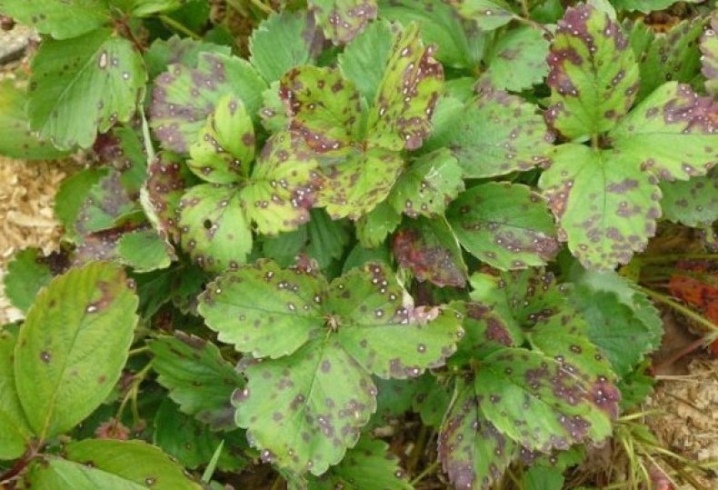
The disease manifests itself in the following dangerous symptoms.
- Small specks of irregular shape and in large quantities form on the foliage of plants. Their color is usually carmine red and their diameter ranges from 1 to 5 mm.
- Characteristic dark pads in the form of small dots appear on the affected tissues of the berries.
- Symptoms are especially pronounced on old and fully developed outer leaf blades, which eventually turn red and lose their color brightness.
- If pathogenic microorganisms have spread significantly, and there is also a strong infection, then the spots that appear are able to merge with the appearance of large red-brown necrotic areas.
- Leaves that have been infected begin to die off.
- The manifestation of symptoms on other elements of the growing bush necessarily leads to their desiccation, a decrease in growth rates. The condition of the plants deteriorates as a whole.
Brown spot must be dealt with correctly. A number of fungicides that are used to combat gray mold are capable of limiting the intensity of brown spotting. Today, summer residents often use a remedy such as Vaxiplant SL for preventive protection.
A remarkable effect is demonstrated by prophylactic spraying of plants with Bordeaux liquid, which is popular among summer residents (1%).
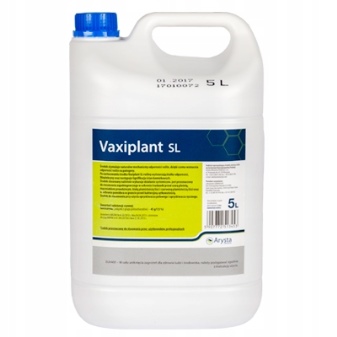
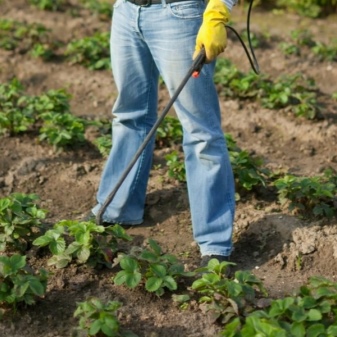
Anthracnose
A serious disease that causes considerable harm to strawberries, reducing its yield. If there are all favorable conditions for the growth of mushrooms, then the losses provoked by anthracnose can reach up to 80%.
The causative agent of the disease in question is the dangerous fungus Colletotrichum acutatum. The fungus develops very actively against the background of warm weather. And also increased dampness with a large amount of precipitation leads to the development of dangerous ailments.
If the plants are characterized by excessive density, grow in conditions of an impressive level of humidity, then sooner or later anthracnose appears. Fungi can also enter the area along with seedlings that have previously been infected. Often, the harmful pathogen lives hidden in the plantings, therefore it can develop exclusively in the most favorable environment.
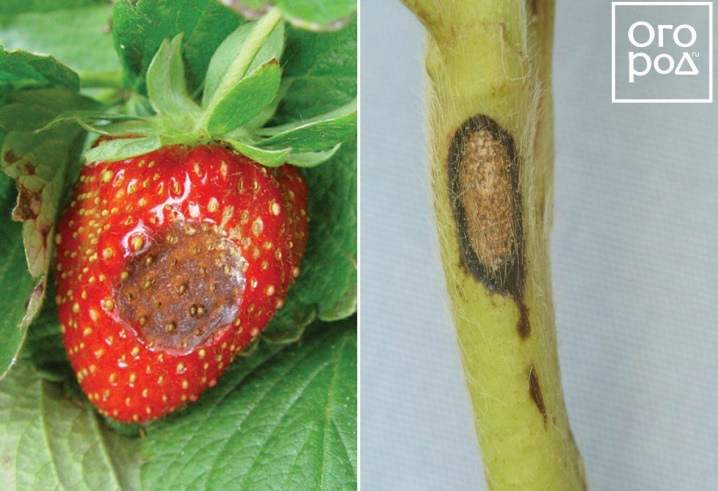
Anthracnose is capable of infecting almost any plant area, be it flowers, young buds, stems, shoots, berries. If this disease appears, then slightly recessed spots are formed. They are able to become covered with conidial fungal spores.
If varieties of berries are grown on the site that are more susceptible to anthracnose, then they must be sprayed with special preparations in preventive measures, especially during flowering and the initial growth of fruits. The popular Scorpion 325 SC demonstrates very good performance, which is an interventional fungicide.
When using it, you should withstand short waiting times, amounting to 3 days.
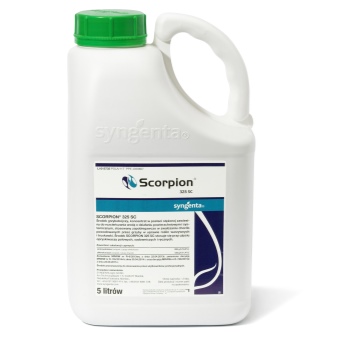
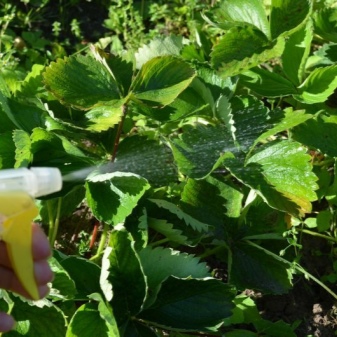
White leaf spot
Frequent ailment. Leads to a noticeable decline in yield, negatively affects the quality of the fruit. Consider the main symptoms of white leaf spot.
- On the upper part of the leaf plates, various spots are formed, which over time "capture" more extensive areas.
- And also light spots appear with brown edges.
Especially strong and extensive lesions with white spot can occur on old stands, especially if the plant density is high.
The disease is developing especially actively in areas that were previously covered with a film or special agrotextile. After harvesting these materials, you need to immediately assess the possible threat, because even a minimal damage runs the risk of ending up with a wide spread of the infection.
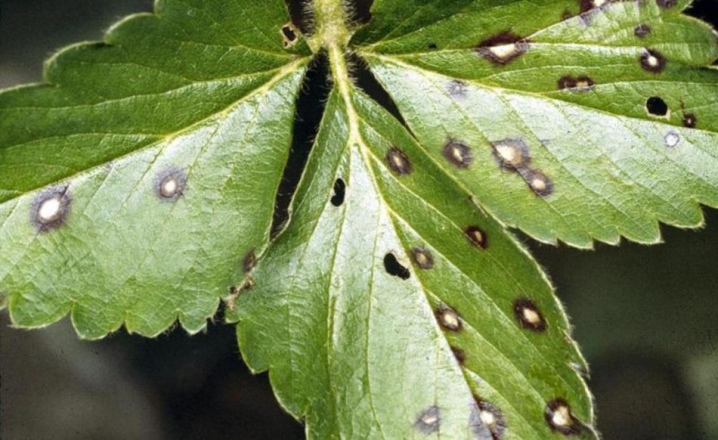
If the lesion with white spot is quite strong, then it is advisable to carry out the first processing procedures immediately after the onset of the initial symptoms. Most often we are talking about the period before and during flowering. Towards the end of the season, in the fall, it is necessary to process the berries if the disease is severe.
The following preparations are best for use before flowering:
- Vaxiplant SL;
- Domark 100 EC;
- Yamato 303 SE (in warm weather conditions);
- Nordox 75 WG and others.

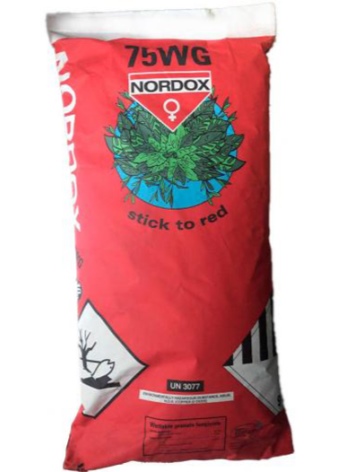
Bacterial angular leaf spot
This nuisance can lead to large losses, especially in those years when the amount of precipitation becomes too large. Let's take a look at the typical symptoms that manifest bacterial spotting.
- Initially, the disease manifests itself in the form of the formation of small and chaotically scattered spots with a watery structure. Their diameter can be from 1 to 4 mm. These spots become noticeable only in the lower zone of the leaf blades.
- With the development of the disease, the spots will grow, merge with each other. They move to the outer part of the leaves, they look like angular red-brown moistened specks.
- Against the background of a high humidity level of the air, dried out areas can acquire an unusual brown tint for them.
- When areas with a changed color become numerous, they begin to merge in lines along the main and lateral veins.
- Dangerous bacteria can spread to other plants planted on the site.
If the risk of this disease is high, it is recommended to use copper-containing fertilizers. For example, the variants Nordox 75 WG and Viflo CuB are characterized by very good action. They also contain essential and useful trace elements.
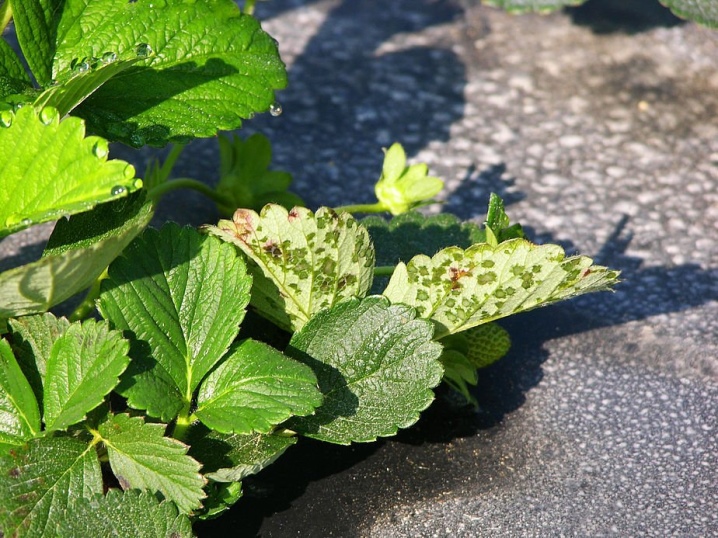
Such fertilizers have an absolutely safe effect, especially during flowering and throughout the entire growing season.
Verticillosis
This disease is fungal. It attacks plants especially quickly on days when the weather is warm or humid. The disease manifests itself by dying away, which begins from the lower leaves. After a while, the lesion spreads to the entire bush, provoking its death. Typically, verticillosis attacks the roots and rosette of plants.
The disease has the following symptoms.
- The appearance of a brown color on the edges of foliage, loss of turgor, dying off.
- Changing the size of young foliage.
- Closer to the end of the growing season, the petioles of the leaf blades turn red.
- Diseased bushes lag behind in their growth.
- The internal component of the root becomes brown, dies off.
In the fight against this ailment, you can use horsetail extract or Topsin M500 SC. The latter drug is able to treat plants that are already affected by verticillium. And also it can be used for preventive operations.
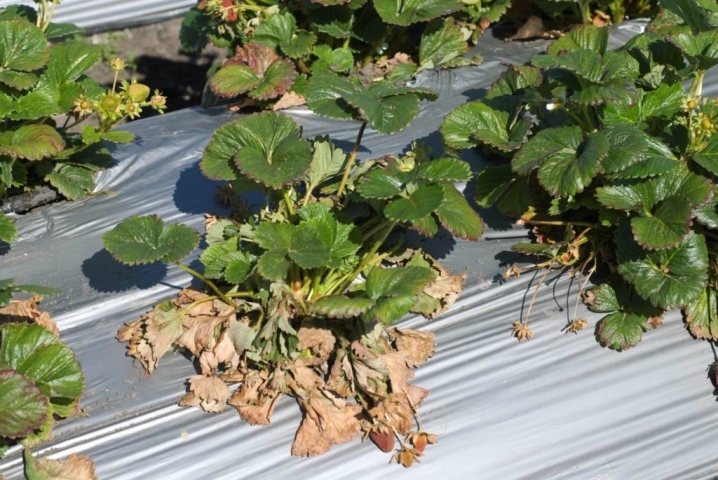
Before using the concentrate, it must be diluted with water.
Yellowing of the edges of the leaves
The course of this viral disease passes without symptoms. It is not too dangerous for strawberries. Causes a slower growth of plantings, leads to yellowing of the leaf blades. To overcome this disease, you can turn to spraying with aphids. It is this pest that carries the virus, most often attacks remontant strawberries.
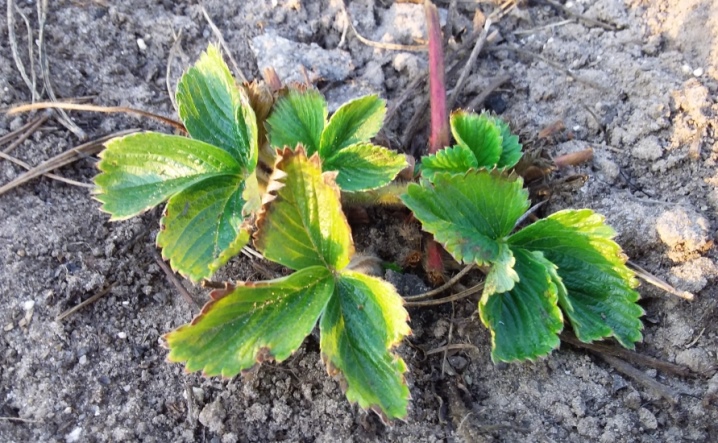
Late blight root rot
A dangerous disease caused by the fungus Phytophthora fragariae var. Fragariae. The pathogen is capable of infecting young roots, causing them to rot in the upper part. Infected rhizomes will certainly die off, and then completely separate. The root system is reduced in size. Rotting particles often resemble rat tails. The foliage of diseased plantings loses its normal color, becomes dull.
Let's analyze the main methods of protection against this serious ailment.
- It is necessary to initially plant healthy seedlings.
- Planting is required on sufficiently drained soils.
Chemicals aimed at effectively combating root rot have not yet been registered.
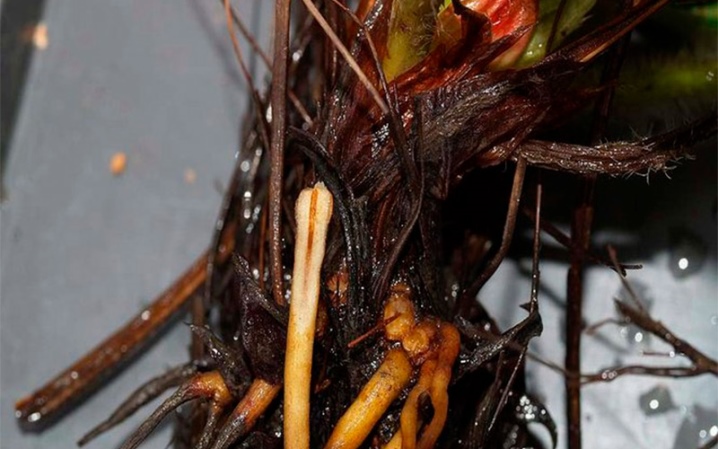
How to get rid of pests?
Let us examine a description of some effective methods of dealing with pests affecting strawberries.
- May beetle larvae, the length of which ranges from 2 to 5 cm, can harm strawberries. They have a creamy white color, curved shape. Plants attacked by these pests wither and then dry out altogether. A beetle that has settled in a garden bed can eat the foliage of plants, bite off the pulp of the fruit. Fight against these parasites should be started in advance, before planting crops. This is done from the end of April to August, using preparations containing chlorpyrifos.The products must be mixed with the soil.
- Dangerous for strawberries and strawberry-raspberry weevil. It attacks the buds of the fruit, leaving deep holes in them. In them, the female of the parasite lays eggs, gnaws the stem of the bud so that it falls off. To combat this pest, pruning and burning of dried plant residues from the beds is carried out. They resort to spraying with the preparation "Karate" at the moment the buds come out.
- Spider mites can cause very serious harm to strawberries. It is small in size and yellow-green in color. The parasite attacks the planting by feeding on the underside of the leaf blades. The appearance of a tick may be indicated by the formed cobweb and yellowish spots. Bushes can be saved with Neudosan spray, Talstar 100 EC insecticide, Ortus 05 SC, Envidor 240 SC before flowering, and Safran 018 EC after flowering.
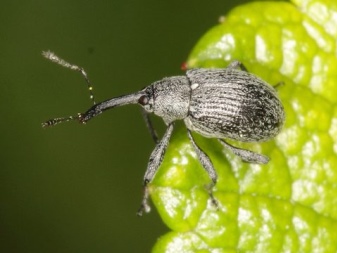
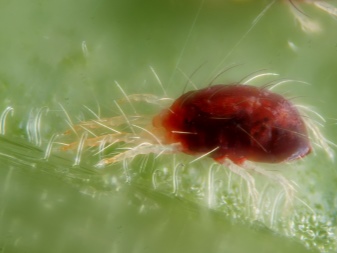
Prevention measures
Let's get acquainted with the main preventive measures that can effectively prevent the appearance of diseases and parasites that attack strawberries.
- It is strongly discouraged to plant the plants too densely and closely to each other. Each unit should grow separately, without touching adjacent bushes. Very often, non-observance of this condition is the main cause of many problems.
- For prevention purposes, it is allowed to sprinkle strawberry beds with chopped wood ash. For 1 square of the cultivated area, it is enough to take up to 70 g of ash.
- Planting onions or garlic in the aisle will serve as a wonderful preventive measure.
- It is recommended to choose for cultivation only those strawberry varieties that are resistant to various kinds of diseases. And you can also give preference to hybrid varieties.
- It is recommended to grow strawberries on special agrofibre. Thanks to this component, it is possible to form neat and even beds, protect bushes from unnecessary and harmful weeds, and stop the spread of dangerous parasites.
- It is always necessary to keep under control the condition of the plantings on the site. It is required to monitor the strawberries both before and after harvest. In addition, you need to regularly get rid of overgrowing weeds. The soil must be sufficiently loosened.
- The emergence of a huge number of problems can prevent the usual observance of all the rules of agricultural technology when planting strawberries on the site.
- Strawberries need correct and timely spring and autumn feeding. They must be entered strictly according to the instructions.
- For planting the crop in question, it is advisable to choose only those sites that have access to a sufficient amount of natural light.
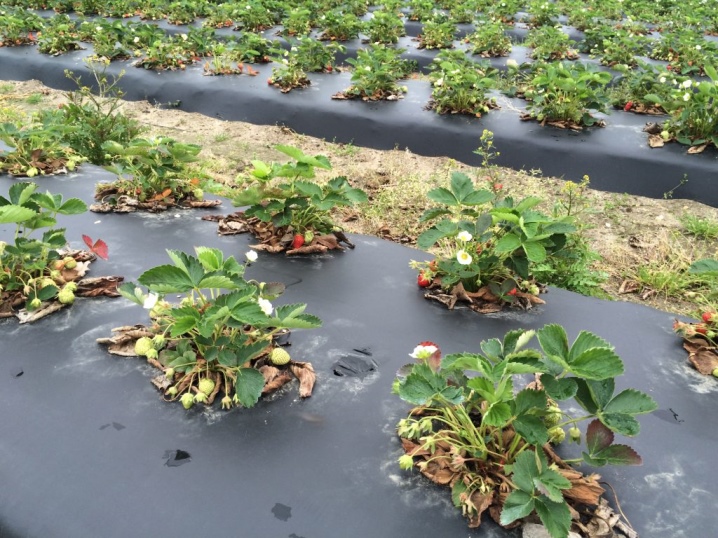













The comment was sent successfully.